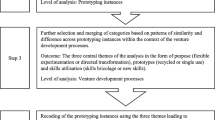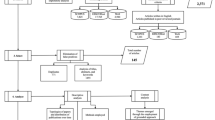Abstract
Our work pursues a twin aim. Firstly, we explore the influence of organizational size on innovations in museums as well as its impact on museums’ economic, market and social performance. Secondly, we analyse how the (public–private) funding of such organizations impacts innovation and performance. The empirical work is based on information from a survey of 491 museums (British, French, Italian and Spanish). We find that museum size does prove relevant in the commitment to engage in innovation but that public funding of museums does not encourage innovation. We also highlight the importance of the explanatory power of the type of funding on the performance of these cultural organizations. This research also reveals how organizational and technological innovations as well as innovation in value creation in museums enhance economic, market and social performance.
Similar content being viewed by others
References
Agarwall, S., Erramilli, K., & Dev, C. H. (2003). Market orientation and performance in service firms: Role of innovation. Journal of Services Marketing, 17(1), 68–82.
Albi, E. (2003). Economía de las Artes y Política Cultural. Madrid: Instituto de Estudios Fiscales.
Argyris, C., & Schon, D. (1978). Organizational learning: A theory of action perspective. Reading, MA: Addison-Wesley.
Bakhshi, H., & Throsby, D. (2009). Innovation in arts and cultural organisations: Interim research report. London: NESTA.
Bakhshi, H., & Throsby, D. (2010). Culture of innovation: An economic analysis of innovation in arts and cultural organisations. London: NESTA.
Baumol, W. J., & Bowen, W. G. (1966). Performing arts. The economic dilemma. New York: The Twentieth Century Fund.
Benhamou, F. (1998). The Contradictions of Désétatisation: Museums in France. In P. B. Boorsma, A. Van Hemel, & N. Van der Wielen (Eds.), Privatization and culture. Dordrecht: Kluwer.
Bertschek, I., & Entorf, H. (1996). On nonparametric estimation of the Schumpeterian link between innovation and firm size: Evidence from Belgium, France, and Germany. Empirical Economics, 21(3), 401–426.
Bracey, G. (1998). An optimal size for high schools? Phi Delta Kappan, 79(5), 406–408.
Brooks, A. C. (1997). Economic strategies for orchestras. Evanston, IL: Symphony Orchestra Institute.
Burt, E., & Taylor, J. (2003). News technologies, embedded values, and strategic change: Evidence from the U.K. voluntary sector. Nonprofit and Voluntary Sector Quarterly, 32(1), 115–127.
Burton, C., Louviere, J., & Young, L. (2009). Retaining the visitor, enhancing the experience: Identifying attributes of choice in repeat museum visitation. International Journal of Nonprofit and Voluntary Sector Marketing, 14(February), 21–34.
Burton, C., & Scott, C. (2003). Museums: Challenges for the 21st century. International Journal of Arts Management, 5(2), 56–68.
Caladarci, T., & Cobb, C. D. (1996). Extracurricular participation, school size, and achievement and self-esteem among high school students: A national look. Journal of Research in Rural Education, 12(2), 92–103.
Camarero, C., & Garrido, M. J. (2008). The role of innovation in the relation between market orientation and performance in cultural organizations. European Journal of Innovation Management, 11(3), 413–434.
Camisón, C., Lapiedra, R., Segarra, M., & Boronat, M. (2009). A meta-analysis of innovation and organizational size. Organization Studies, 25(3), 331–361.
Cohen, W. M., & Klepper, S. (1996). A reprise of firm size and R&D. Economic Journal, 106, 925–951.
Diamanpour, F. (1987). The adoption of technological, administrative, and ancillary innovations: Impact of organizational factors. Journal of Management, 13, 675–688.
Diamanpour, F. (1991). Organizational innovation: A meta-analysis of effects of determinants and moderators. Academy of Management Journal, 34, 555–590.
Diamanpour, F. (1992). Organizational size and innovation. Organization Studies, 13(3), 375–402.
Duffy, C. T. (1992). The rationale for funding of a National Museum. In R. Towse & A. Khakee (Eds.), Cultural economics. Berlín: Springer.
Frey, B. S. (2000). Arts and economics. Berlin: Springer.
Frey, B. S., & Meier, S. (2002). Museums between private and public. The case of the Beyeler Museum in Basle. Working paper series, n. 116. Institute for empirical research in economics. University of Zurich.
Frey, B. S., & Meier, S. (2006). The economics of museums. In V. A. Ginsburgh & D. Throsby (Eds.), Handbook of the economics of art and culture. Amsterdam: North Holland.
Gainer, B., & Padanyi, P. (2005). The relationship between market-oriented activities and market-oriented culture: Implications for the development of market orientation in nonprofit service organizations. Journal of Business Research, 58, 854–862.
Han, J., Kim, N., & Srivastava, R. (1998). Market orientation and organizational performance: Is innovation a missing link? Journal of Marketing, 62, 30–45.
Heilbrun, J., & Gray, C.M. (1993). The economics of arts and culture: An American perspective. Cambridge: Cambridge University Press.
Hikmet, N., Bhattacherjee, S., Menachemi, N., Kayhan, V., & Brooks, R. (2008). The role of organizational factors in the adoption of healthcare information technology in Florida hospitals. Health Care Manage Science, 11, 1–9.
Hughes, P., & Luksetich, W. (2004). Nonprofit arts organizations: Do funding sources influence spending patterns? Nonprofit and Voluntary Sector Quarterly, 33(2), 203–220.
Hull, C., & Lio, B. (2006). Innovation in non-profit and for-profit organizations: Visionary, strategic, and financial considerations. Journal of Change Management, 6(1), 53–66.
Hult, T., Hurley, R., & Knight, G. (2004). Innovativeness: Its antecedents and impact on business performance. Industrial Marketing Management, 32, 429–438.
Kamien, M. I., & Schwarz, N. L. (1982). Market structure and innovation. Cambridge: Cambridge University Press.
Kawashima, N. (1999). Privatizing museum services in UK local authorities. New managerialism in action? Public Management Review, 1(2), 157–178.
Kirchner, T. A., Markowski, E. P., & Ford, J. B. (2007). Relationships among levels of government support, marketing activities, and financial health of nonprofit performing arts organizations. International Journal of Nonprofit and Voluntary Sector Marketing, 12(May), 95–116.
Laforet, S. (2008). In P. Pablos, & M. D. Lytras (Eds.), Chinese consumers' attitudes and adoption of online and mobile banking.
Lam, A. (2004). Organizational innovation. Brunel Business School, Brunel University, BSBM, Working Papers, Uxbridge, 1(2), 8–45.
McDonald, R. (2007). An investigation of innovation in nonprofit organizations: The role of organizational mission. Nonprofit and Voluntary Sector Quarterly, 36(2), 256–281.
McDonald, H., & Harrison, P. (2002). The marketing and public relations practices of Australian performing arts presenters. International Journal of Nonprofit and Voluntary Sector Marketing, 7(2), 105–117.
McDonald, R., & Srinivasan, N. (2004). Technological innovations in hospitals: What kind of competitive advantage does adoption lead to? International Journal of Technology Management, 28(1), 103.
McNichol, T. (2005). Creative marketing strategies in small museums: Up close and innovative. International Journal of Nonprofit and Voluntary Sector Marketing, 10, 239–247.
Mintzberg, H. (1979). The structuring of organizations: A synthesis of the research. Prentice-Hall: Englewood Cliffs, NJ.
Mottner, S., & Ford, J. (2004). Measuring nonprofit marketing strategy performance: The case museum store. Journal of Business Research, 58(6), 829–850.
Olson, J., Belohlav, J., & Boyer, K. (2005). Operational, economic and mission elements in not-for-profit organizations: The case of the Chicago Symphony Orchestra. Journal of Operations Management, 23(2), 125–142.
Osborne, S. P., Chew, C., & McLaughlin, K. (2008). The once and future pioneers? The innovative capacity of voluntary organizations and the provision of public services: A longitudinal approach. Public Management Review, 10(1), 51–70.
Pincus, A. L. (1998). Tanglewood: The clash between tradition and change. Boston: Northeastern University Press.
Rentschler, R., & Wood, G. (2001). Cause related marketing: Can the arts afford not to participate? Services Marketing Quarterly, 22(1), 57–69.
Sala i Martín, X. (1994). Cross-sectional regressions and the empirics of economic growth. European Economic Review, 38, 739–747.
Scheff, J., & Kotler, P. (1996). Crisis in the arts: The marketing response. California Management Review, 39(1), 28–52.
Schumpeter, J. (1942). Capitalism, socialism and democracy (p. 519). New York, NY: Harper.
Schuster, J. M. (1998). Beyond privatization: the hybridization of museums and built heritage. In P. B. Boorsma, A. Van Hemel, & N. Van der Wielen (Eds.), Privatization and culture. Dordrecht: Kluwer.
Shefer, D., & Frenkel, A. (2005). R&D, firm size and innovation: An empirical analysis. Technovation, 25, 25–32.
Stock, G. N., Greis, N. P., & Fischer, W. A. (2002). Firm size and dynamic technological innovation. Technovation, 22, 537–549.
Stone, L. D. (1995). Changing how the arts conducts itself. Business Quarterly, 59(spring), 52–55.
Throsby, D. (1998). Rethinking the State’s role: Privatization, economics and cultural policy. In P. B. Boorsma, A. Van Hemel, & N. Van der Wielen (Eds.), Privatization and culture. Dordrecht: Kluwer.
Voss, G., Montoya-Weiss, M., & Voss, Z. (2006). Aligning innovation with market characteristics in the nonprofit professional theater industry. Journal of Marketing Research, 43(1), 296–302.
Xue, Y., Liang, H., & Boulton, W. R. (2008). Information technology governance in information technology investment decision processes: The impact of investment characteristics, external environment, and internal context. MIS Quarterly: Management Information Systems, 32(1), 67–96.
Acknowledgments
This work is framed within the Research Project SEJ2007-67095/ECON funded by the Department for Research and Management of the National R&D&I Plan (Ministry of Science and Innovation).
Author information
Authors and Affiliations
Corresponding author
Rights and permissions
About this article
Cite this article
Camarero, C., Garrido, M.J. & Vicente, E. How cultural organizations’ size and funding influence innovation and performance: the case of museums. J Cult Econ 35, 247–266 (2011). https://doi.org/10.1007/s10824-011-9144-4
Received:
Accepted:
Published:
Issue Date:
DOI: https://doi.org/10.1007/s10824-011-9144-4




